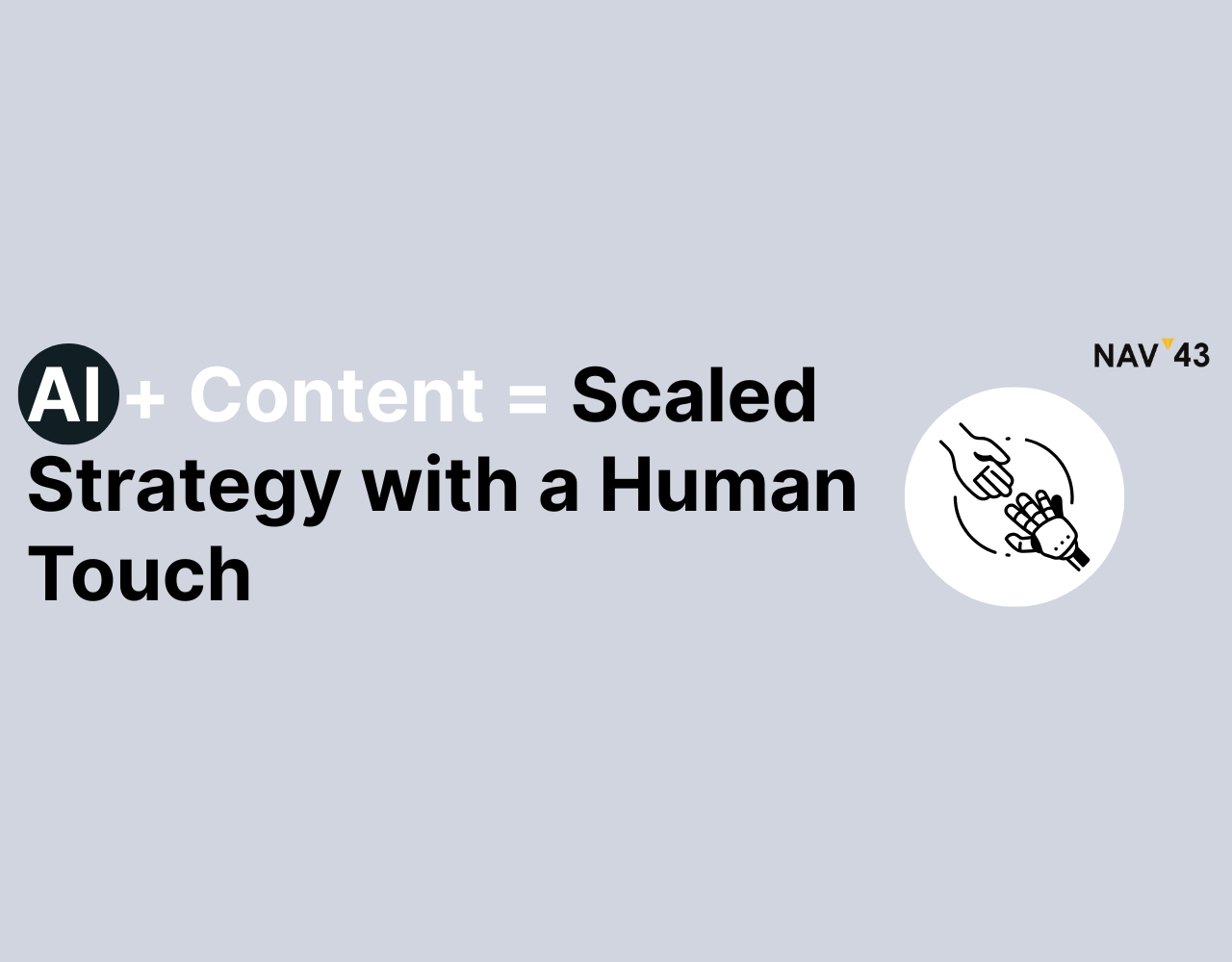
The Future of Content Creation with AI: Trends, Opportunities, & Challenges
As CEO of NAV43, I’ve watched AI reshape the digital marketing landscape firsthand. What began as basic text generation has evolved into sophisticated content creation systems that are transforming how brands connect with audiences. But here’s what most marketing leaders miss: the true power of AI in content creation isn’t about replacement—it’s about amplification. The future of AI promises even greater advancements in automation, personalized content recommendations, and enhanced user engagement.
How AI is Reshaping Content Creation
The evolution of AI in content marketing has been nothing short of remarkable. Just five years ago, most AI-generated content was easily identifiable by its robotic tone and awkward phrasing. Today, the digital landscape has dramatically shifted.
From automation to augmentation: The evolution of AI-powered content
AI’s role in content creation has undergone a fundamental transformation. Early iterations focused primarily on automating basic tasks – think grammar checks and simple headline generation. These tools saved time but added minimal creative value. Today, AI-powered tools enhance content creation processes by automating various tasks such as writing, editing, and distribution, allowing content creators and marketers to generate high-quality, personalized content that resonates with target audiences.
The watershed moment came with advanced language models capable of generating human-like text. Suddenly, AI evolved from a simple automation tool to a genuine creative partner. This shift represents what we at NAV43 call the “augmentation revolution” – where AI enhances rather than replaces human creativity.
What makes today’s AI content tools different is their ability to understand context, tone, and even emotional nuance. This evolution mirrors what we’ve seen with other transformative technologies: initial skepticism gives way to strategic integration as capabilities mature.
Key AI technologies driving the future of content
Three key technologies are reshaping how we approach content creation:
- Natural language processing (NLP): Modern NLP systems understand semantic relationships and contextual nuances that were impossible just a few years ago. This enables AI to generate content that reflects brand voice and understands audience intent.
- Machine learning and generative AI: These systems can analyze vast datasets of successful content to identify patterns in engagement, conversion, and audience response. This data-driven approach helps create content that resonates with specific target audiences. AI algorithms can segment users based on their behaviors and preferences through data analysis, providing personalized content recommendations that enhance user engagement and satisfaction.
- AI-powered content curation and distribution: Beyond creation, AI now optimizes when, where, and how content reaches audiences. These systems analyze performance data in real-time to refine distribution strategies for maximum impact.
At NAV43, we’ve integrated these technologies into our content development process, creating a hybrid approach that leverages both AI capabilities and human creativity.
The rise of generative AI: Hype vs. reality
The explosion of AI content tools has created both excitement and misconceptions. Let’s separate fact from fiction:
Current reality of AI-generated content:
- Automated content generation is excellent for creating first drafts and structural frameworks
- Effective for data-driven content like product descriptions and reports
- Valuable for scaling content production across multiple channels
Persistent limitations:
- Struggles with original strategic insights
- Limited ability to create truly novel ideas
- Lacks the emotional intelligence needed for sensitive topics
- Cannot replace authentic human experiences and perspectives
The most successful brands understand this distinction, using AI where it excels while preserving human input for strategic and emotional elements.
Benefits of Using AI for Content Creation
The strategic advantages of AI-powered content creation extend far beyond simply saving time or reducing costs. When implemented thoughtfully, AI transforms content marketing fundamentals and enables content creators to better engage their audience through data-driven insights and personalized recommendations.
Scaling content production without sacrificing quality
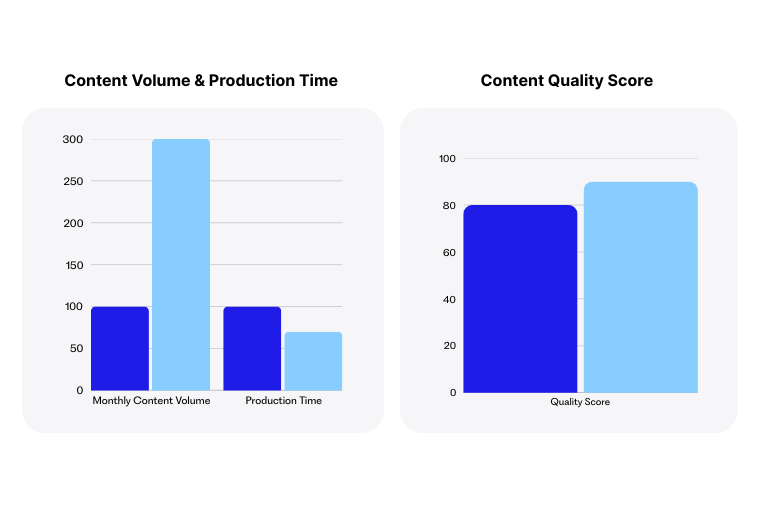
One of the most compelling benefits of AI content tools is their ability to dramatically increase high quality content production.
A media client recently approached us with a common challenge: they needed to produce specialized content across multiple industry verticals but lacked the budget for dedicated writers in each field. By implementing an AI-assisted workflow, their team achieved:
- 67% increase in content production volume
- 42% reduction in time spent on research
- Consistent quality ratings across all content categories
The key to this success was developing a system where AI handled research compilation and draft generation, while human editors shaped messaging strategy and added brand-specific insights.
AI-driven personalization and hyper-targeted content
Content personalization has evolved from “nice-to-have” to “essential” status. AI makes sophisticated personalization possible at scale by:
- Analyzing user behavior patterns to predict content preferences and analyze vast amounts of data to generate personalized content and recommendations
- Dynamically adjusting messaging based on audience segments
- Creating variations that speak to different buyer personas
Bold insight: Personalization isn’t just about inserting a customer’s name into an email. True AI-driven personalization adapts entire content structures based on where prospects are in their buyer journey.
SEO optimization powered by AI insights
The relationship between AI and SEO represents one of the most valuable applications of this technology. Modern AI tools can:
- Identify semantic keyword opportunities beyond traditional keyword research
- Predict content gaps in competitive landscapes
- Analyze top-performing content to extract structural patterns
- Recommend content optimizations based on search intent signals and deliver relevant content to specific audiences
What makes AI particularly valuable for SEO is its ability to process enormous datasets and identify patterns that would be invisible to manual analysis. This capability has transformed our approach to content optimization at NAV43.
Human Creativity vs. AI: Finding the Right Balance
The most powerful content strategies don’t choose between human creativity and AI capabilities—they leverage both through strategic integration, embracing AI to transform writing, editing, and distribution processes.
Why AI will not replace human writers
Despite tremendous advances, AI faces fundamental limitations that preserve the essential role of human writers:
- Experience-based insights: AI cannot draw from lived experiences or professional expertise. When I write about marketing challenges I’ve personally navigated with clients, that perspective comes from years of hands-on work that AI simply cannot replicate. Additionally, human writers can create engaging content that resonates with consumers, fostering growth and aligning with their values and interests.
- Emotional intelligence: Truly compelling content often requires understanding emotional nuances and cultural contexts that are beyond AI’s capabilities. This is particularly important for sensitive topics or emotionally driven messaging.
- Strategic vision: While AI excels at pattern recognition, it struggles with the creative leaps and intuitive connections that drive breakthrough content strategies. Human writers bring conceptual thinking that exists beyond data patterns.
- Ethical judgment: Content decisions often involve complex ethical considerations that require human judgment. AI lacks the moral reasoning capabilities needed for these decisions.
These limitations aren’t likely to disappear with incremental technological improvements – they represent fundamental gaps in how AI systems operate compared to human creators.
AI as a content collaborator, not a replacement
The most productive perspective views AI as a collaborative partner in the content creation process. This partnership works best when roles are clearly defined:
Ideal AI responsibilities:
- Research compilation and fact-checking
- Draft generation and structure development
- Optimization recommendations
- Performance analysis
- Repetitive content production (like product descriptions)
Human responsibilities:
- Strategic direction and messaging
- Brand voice oversight
- Emotional elements and storytelling
- Final quality control
- Creative ideation
At NAV43, we’ve developed a collaborative workflow where content strategists define objectives, AI generates initial drafts, and professional writers refine and enhance the output. This approach has consistently delivered higher-quality content than either humans or AI could produce independently.
Striking the balance between automation and authenticity
Finding the right balance between AI efficiency and human authenticity requires intentional planning and clear guidelines. Here are the principles we follow:
- Maintain transparency: We’re always transparent with audiences about how and where AI is used in content creation.
- Prioritize value delivery: The ultimate question isn’t “Was this created by AI?” but rather “Does this content deliver genuine value to our audience?”
- Preserve brand voice: AI tools should be trained on brand-specific content to ensure consistency with established voice and messaging.
- Establish clear review processes: Human oversight remains essential, with appropriate review protocols based on content sensitivity and importance.
- Continuous improvement: Regular evaluation of AI outputs helps refine systems and identify areas where human input adds the most value.
The goal isn’t to mimic human writing perfectly but to create a sustainable system that leverages the strengths of both AI and human creators.
Future Trends in AI-Driven Content Creation
Where is AI-powered digital content headed? Based on current trajectories and emerging technologies, several key trends will shape content creation in the coming years.
AI-generated videos and multimedia content
Text generation represents just the beginning of AI’s creative capabilities. Visual content creation is rapidly advancing:
- AI-powered video generation: Systems can now create basic video content from text prompts, with quality improving dramatically each year.
- Script and storyboard development: AI excels at creating structured video outlines and scripts based on content objectives.
- Visual editing assistance: Tools can analyze video footage to recommend edits, transitions, and even emotional tone adjustments.
- Personalized video at scale: Perhaps most exciting is AI’s ability to create multiple variations of video content customized for different audience segments.
While fully AI-generated videos still face quality limitations, hybrid approaches—where AI handles structured elements and humans contribute creative direction—are already delivering impressive results. These advancements in AI are transforming how users consume content, enabling platforms to deliver tailored content recommendations and enhancing user engagement.
AI-driven storytelling and brand narratives
Storytelling remains central to effective marketing, and AI is increasingly capable of contributing to narrative development:
- Structure and framework generation: AI excels at creating story structures based on proven narrative patterns.
- Character and scenario development: Systems can generate diverse scenarios and character profiles to illustrate brand messages.
- Adaptation of core narratives: AI can effectively adapt central brand stories for different channels and formats while maintaining consistency.
Bold insight: The most effective AI-driven storytelling doesn’t attempt to create the core brand narrative but instead helps scale and adapt foundational stories created by human strategists.
AI and real-time content adaptation
Perhaps the most transformative potential of AI lies in creating truly dynamic content experiences:
- Real-time personalization: Content that adjusts instantaneously based on user behavior and preferences.
- Contextual adaptation: Messages that shift based on external factors like time, location, or even weather.
- Interactive content development: AI that can engage in meaningful back-and-forth exchanges with users, creating genuinely conversational experiences.
These capabilities are rapidly moving from experimental to mainstream, with early adopters already seeing significant engagement benefits.
The Evolving AI Content Ecosystem
The future of content creation with AI extends beyond standalone tools to encompass an interconnected ecosystem of specialized solutions and technologies. Understanding these developments, including how AI algorithms can generate coherent and engaging social media posts, is crucial for organizations looking to stay ahead of the curve.
The Integration Imperative: Building Connected Content Workflows
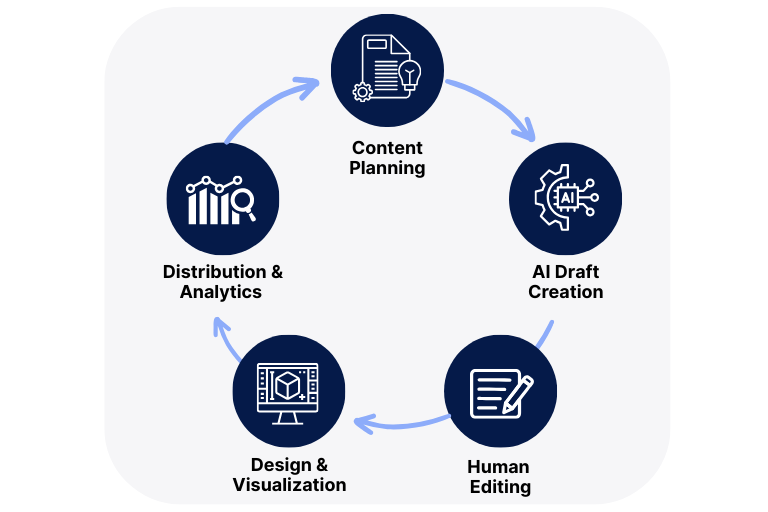
One of the most significant shifts we’re witnessing is the move from isolated AI tools to integrated content ecosystems. Similar to broader SaaS trends, the AI content landscape is evolving toward specialized solutions that work together seamlessly.
Bold insight: No single AI platform will excel at everything—success will depend on building connected workflows across specialized tools.
These integrations are already transforming how content teams operate:
- Cross-platform content development: AI writing tools feeding directly into design platforms like Canva for seamless visual content creation
- Automated content distribution: Content generation systems connecting directly to publishing and distribution platforms
- Analytics integration: Performance data automatically influencing future content creation
At NAV43, we’ve seen firsthand how these integrated workflows dramatically increase efficiency. One of our enterprise clients reduced their content production cycle by 62% after implementing an integrated AI ecosystem that connected content generation, design, and distribution tools.
Native RAG: The Future of Contextual AI Content Creation
Retrieval Augmented Generation (RAG) represents one of the most promising developments in addressing AI’s current limitations.
What makes RAG transformative is its ability to combine the creative capabilities of language models with access to specific, relevant information sources. This addresses several critical challenges:
- Reducing hallucinations: By grounding AI responses in verified information sources
- Incorporating recent information: Connecting AI to continuously updated knowledge bases
- Enhancing data security: Allowing organizations to leverage proprietary information without fully sharing it with external AI systems
While RAG implementations were initially complex custom solutions, major platforms like Google and Microsoft are now rolling out native RAG capabilities that will make this technology accessible to more organizations.
Bold prediction: Within 18 months, RAG-enhanced content creation will become the standard approach for enterprise content marketing, creating a significant competitive advantage for early adopters.
For content marketers, this means AI-generated content that isn’t just generic—it’s infused with your organization’s unique perspectives, data, and expertise. The result is truly differentiated content that competitors can’t easily replicate.
Hyper-Personalization: Beyond Basic A/B Testing
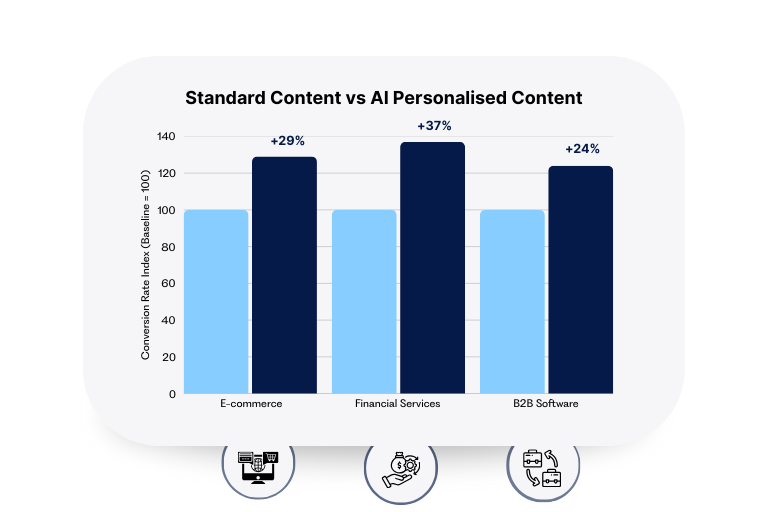
Traditional content personalization relied on simple segmentation and limited testing. AI is completely transforming this approach, enabling:
- Real-time content adaptation: Dynamic adjustment based on user behavior and preferences
- Multi-variant testing at scale: Moving from A/B to “A through Z” testing without proportional resource requirements
- Predictive personalization: Anticipating user needs before they’re explicitly expressed
- Synthetic audience modeling: Using AI to simulate how different audience segments will respond to content variations
One particularly exciting development is the combination of AI content generation with real-time personalization engines. This allows content to be distributed and created differently for each audience segment—or potentially each user.
Human Expertise: The Critical Miles Deep
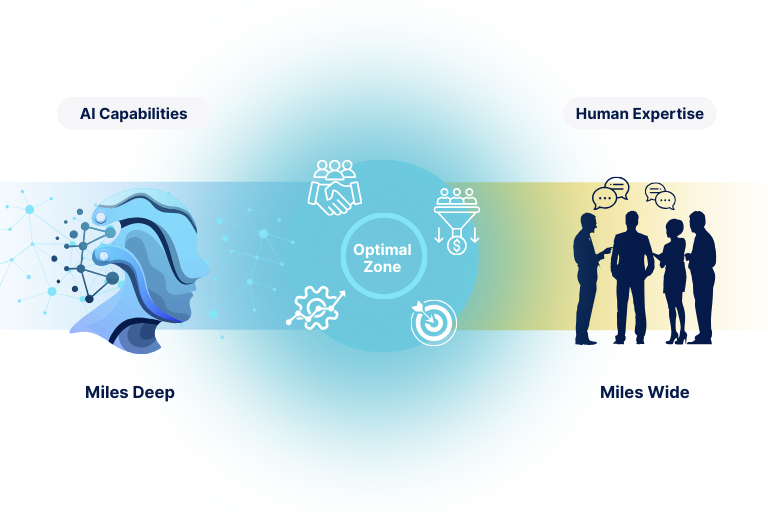
While AI content capabilities continue to expand exponentially, human expertise remains irreplaceable for strategic differentiation.
Bold perspective: AI may be thousands of miles wide, but human expertise provides the critical miles of depth that create genuine competitive advantage.
The most successful organizations are strategically determining where human input adds the most value:
- Audience understanding: Deep knowledge of customer needs, pain points, and aspirations
- Strategic positioning: Differentiated market perspective that stands out from competitors
- Emotional intelligence: Understanding the subtle emotional nuances that drive connection
- Creative direction: Guiding the overall creative vision that AI helps execute
- Ethical oversight: Ensuring content aligns with organizational values and social responsibility
In our experience, organizations that clearly define these human contribution zones achieve significantly better results than those who either over-rely on AI or resist its implementation.
Visual Content Evolution: Collaborative Learning Between Humans and AI
AI-powered image and video creation is advancing at a remarkable pace, but what’s often overlooked is how this technology improves through human interaction.
Each time a user refines an AI-generated image or edits an AI-produced video, the system learns and improves. This creates a virtuous cycle where:
- AI generates initial visual content
- Humans refine and improve the output
- AI learns from these refinements
- Future generations improve based on accumulated refinements
This collaborative learning model is fundamentally different from traditional software development. Instead of discrete updates, AI visual tools continuously evolve based on how they’re used—essentially learning directly from the creative professionals who use them.
For marketing teams, this means investing time in refining AI outputs doesn’t just improve current content—it enhances the system’s ability to meet future needs. Organizations that actively engage in this refinement process gain increasing advantages as their AI tools become more aligned with their specific creative vision.
Bold recommendation: Establish formal feedback loops where your creative team systematically documents how they modify AI-generated visual content, creating a valuable proprietary dataset that can improve future outputs.
How Businesses Can Prepare for AI in Content Marketing
Implementing AI-powered content creation requires strategic planning and thoughtful execution. Here’s how forward-thinking organizations can prepare.
Choosing the right AI tools for content creation
The AI content tool landscape is evolving rapidly, with options ranging from specialized point solutions to comprehensive platforms. Key considerations include:
Technical capabilities to evaluate:
- Quality of generated content
- Customization options for brand voice
- Integration with existing marketing technologies
- Training requirements and learning curve
- Pricing structure and scalability
Leading platforms worth considering:
- Comprehensive solutions like Jasper, Copy.ai, and OpenAI’s commercial offerings
- Specialized tools for specific content types (email, social, long-form)
- Enterprise platforms with advanced customization capabilities
The right choice depends largely on your specific content needs, technical resources, and integration requirements. At NAV43, we typically recommend starting with a focused use case before expanding to broader implementation.
AI content moderation and quality control
As AI content usage increases, so does the importance of robust quality control systems:
- Establish clear quality standards: Define specific criteria for evaluating AI-generated content, including accuracy, brand alignment, and ethical considerations.
- Implement multi-level review processes: Create appropriate review workflows based on content sensitivity and importance.
- Develop AI-specific style guides: Standard style guides should be expanded to include AI-specific guidelines and boundaries.
- Train editors on AI collaboration. Effective editing of AI content requires different skills than traditional editing. Invest in developing these capabilities.
- Monitor performance metrics: Track how AI-generated content performs compared to traditional content across key metrics.
Bold recommendation: Create a formal AI content governance committee that includes marketing, legal, and ethics team representatives to develop clear guidelines for your organization.
The ethical considerations of AI-generated content
The ethical dimension of AI content creation demands careful attention:
- Transparency with audiences: Be honest about how and where AI is used in your content creation.
- Avoiding misinformation: Implement fact-checking processes for all AI-generated content.
- Representation and bias: Actively monitor for and address potential biases in AI outputs.
- Attribution and intellectual property: Respect copyright and establish clear policies on how AI training and outputs relate to intellectual property.
- Employment impact: Consider how AI implementation affects your content team and develop transition plans if roles will change.
Organizations that proactively address these ethical considerations will build stronger audience trust while avoiding potential regulatory issues as AI governance evolves.
Case Studies: AI in Content Creation Success Stories
The most compelling evidence for AI’s content creation potential comes from real-world implementation. Here are three notable examples:
| Brand | How They Use AI in Content Marketing | Results Achieved |
| OpenAI | AI-powered blog writing and chatbot content | 30% reduction in content production time |
| HubSpot | AI-generated email subject lines and copy | 22% higher engagement rates |
| Netflix | AI-driven personalized content recommendations | Increased watch time per user |
Beyond these prominent examples, we’ve seen remarkable results with our own clients:
A mid-market B2B software company implemented an AI-assisted blog creation workflow that increased their content output by 3x while maintaining consistent quality metrics. This expanded content foundation contributed to a 47% increase in organic traffic within six months.
The key to their success wasn’t simply deploying AI tools but developing a strategic integration approach that preserved human oversight while leveraging AI’s efficiency.
The Role of AI in the Future of Content Strategy
AI’s impact extends beyond content creation to reshape entire content strategies.
AI-enhanced content planning and distribution
Strategic content planning benefits tremendously from AI capabilities:
- Content gap analysis: AI tools can identify underserved topics and opportunities within your industry.
- Competitor content monitoring: Systems track competitive content strategies to identify trends and opportunities.
- Audience interest prediction: AI can forecast emerging topics before they become mainstream.
- Distribution optimization: Tools determine optimal publication timing and channel selection based on audience behavior patterns.
Bold insight: The most valuable application of AI in content planning isn’t predicting what content to create—it’s identifying what content NOT to create, helping teams focus resources on genuinely high-potential opportunities.
AI-powered analytics: Measuring content performance
Content measurement becomes dramatically more sophisticated with AI integration:
- Predictive performance modeling: AI can forecast how content will perform based on historical patterns.
- Attribution enhancement: Systems provide more accurate models of how content contributes to conversion paths.
- Competitive benchmarking: AI analyzes competitor content performance to establish realistic performance targets.
- Content ROI calculation: Advanced models help quantify the genuine business impact of content investments.
These capabilities transform content measurement from backward-looking reporting to forward-looking strategic guidance.
AI content creation for emerging platforms
As new platforms emerge, AI facilitates rapid adaptation:
- Metaverse content development: AI helps scale content creation for immersive environments.
- Voice-optimized content: Systems can adapt existing content for voice search and smart assistants.
- AR/VR experiences: AI supports the development of interactive content for augmented and virtual reality.
- Interactive content systems: Tools create branching narrative structures for truly interactive content experiences.
Organizations that leverage AI effectively can expand to these emerging platforms without proportional increases in content creation resources.
-
No, AI cannot completely replace human content creators for several fundamental reasons. While AI excels at generating structured content based on patterns and data, it lacks the emotional intelligence, lived experience, and strategic thinking that human creators bring.
The most effective approach combines AI efficiency with human creativity—using AI to handle routine aspects of content production while preserving human input for strategy, emotional elements, and brand voice oversight. For the foreseeable future, content creation will remain a collaborative process between human experts and AI systems.
-
The "best" AI content tools depend on your specific needs, but several categories are worth exploring:
- Comprehensive platforms: Jasper, Copy.ai, and OpenAI's commercial offerings provide robust general-purpose content generation.
- Specialized tools: Purpose-built solutions exist for specific content types like emails (Phrasee), social media (Lately), and SEO content (SurferSEO).
- Enterprise solutions: Organizations with complex needs may benefit from customized enterprise AI platforms that integrate with existing marketing technology stacks.
When evaluating tools, consider content quality, customization capabilities, integration options, and pricing models. The most important factor is finding a solution that aligns with your specific content requirements and workflow.
-
Maintaining authenticity with AI-generated content requires intentional processes:
- Train AI on brand-specific content: Ensure AI systems understand your unique voice and messaging.
- Establish clear brand guidelines: Develop specific parameters for how AI should represent your brand.
- Implement human review: Maintain appropriate human oversight based on content sensitivity.
- Focus on value delivery: Prioritize providing genuine audience value over perfect mimicry of human writing.
- Be transparent: When appropriate, be open with audiences about how AI is used in your content process.
Authenticity comes not from hiding AI usage but from ensuring all content—regardless of how it's created - genuinely reflects your brand values and delivers meaningful audience value.
-
AI-generated content can be excellent for SEO when implemented properly. Modern search engines prioritize content that delivers genuine value to users, regardless of how it was created. However, several considerations are important:
- Quality oversight: AI content requires human review to ensure it meets quality standards.
- Original insights: The most effective SEO content combines AI efficiency with human expertise and original perspectives.
- Strategic optimization: AI tools can help optimize content structure, but strategic keyword selection and topic development still benefit from human input.
- Continuous improvement: AI systems should be regularly retrained based on performance data to improve results over time.
When used as part of a thoughtful SEO strategy, AI content generation can dramatically increase both the quantity and quality of optimized content, leading to improved search visibility.
-
While all industries can benefit from AI content tools, several sectors show particularly strong results:
- E-commerce: Product descriptions, category pages, and promotional content can be efficiently scaled with AI.
- Financial services: Complex information can be transformed into accessible content tailored to different financial literacy levels.
- Healthcare: Educational content can be customized for various conditions and treatment options while maintaining compliance.
- Real estate: Property descriptions and location-specific content can be generated at scale.
- Travel and hospitality: Destination guides and accommodation information can be efficiently created and personalized.
The common thread among these industries is the need to produce large volumes of structured content that follows consistent patterns while requiring customization for specific audiences or offerings.
